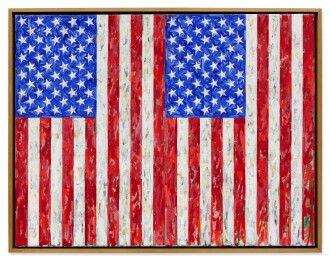Works by Jasper Johns at Sotheby's
Jasper Johns Biography
Recognized as one of the most important artists working in the 20th century, Jasper Johns’ painting has come to be nearly as iconic as it is influential; and, although known predominantly for his works on canvas, his prolific printmaking career has established him as one of the foremost printmakers of any artistic period. Born in Augusta, Georgia, in 1930, and raised in South Carolina, Johns studied briefly at the University of South Carolina before dropping out to move to New York City in 1948. While in New York, he studied for one semester at the Parsons School of Design before, again, dropping out. Leaving Parsons made him eligible for the draft, and he served in the United States Army for two years during the Korean War. Upon returning to New York, Johns befriended several fellow artists working in the city—including Merce Cunningham, John Cage, and, perhaps most importantly, Robert Rauschenberg—each of who inspired Johns’ artistic growth in unique ways.
After meeting, Rauschenberg and Johns developed an intense romantic and artistic relationship, and eventually they moved in together. Their close proximity led to a near constant exchange of ideas and methods, resulting in their respective work being deeply influenced by the other—Johns once mused that he had “learned what an artist was from watching [Rauschenberg].” Further, it was Rauschenberg who introduced Johns to the influential gallerist Leo Castelli, who gave him his first solo exhibition in 1958. The show featured the now iconic painting Flag(1954–55, Museum of Modern Art, New York), and several other paintings all containing variations on the American flag motif. These works, which all presented straightforward representations of recognizable symbols, were starkly at odds with the work of the Abstract Expressionists who were then dominating the art world; nevertheless, the show garnered high praise from critics and curators alike, and a number of works were sold directly to museums—unheard of for an essentially unknown artist.
In the first years of the 1960s, Johns practice took a decided shift away from colorful and bright compositions to more somber, austere color palettes, a change that many have attributed to the tumultuous end of his relationship with Rauschenberg from around the same time. He also began incorporating structural components (in the vein of Marcel Duchamp) onto his canvases, before beginning to include autobiographical references in his work in the 1970s. Despite becoming increasingly reclusive, his work has come to be understood as a critical juncture between Abstract Expressionism and subsequent movements, such as Pop art, Minimalism, and Conceptual Art. His artistic accomplishments, both in his actual work and its influence, have been consistently lauded and acknowledged through numerous exhibitions and awards, such as the Grand Prize for Painting at the 1988 Venice Biennial, the National Medal of Arts in 1990, and Presidential Medal of Freedom in 2011. He continues to live and work in Sharon, Connecticut, and his work can be found in numerous prestigious collections, including the Metropolitan Museum of Art, New York; the National Gallery, Washington, DC; the Tate Modern, London; and the Centre Pompidou, Paris.












